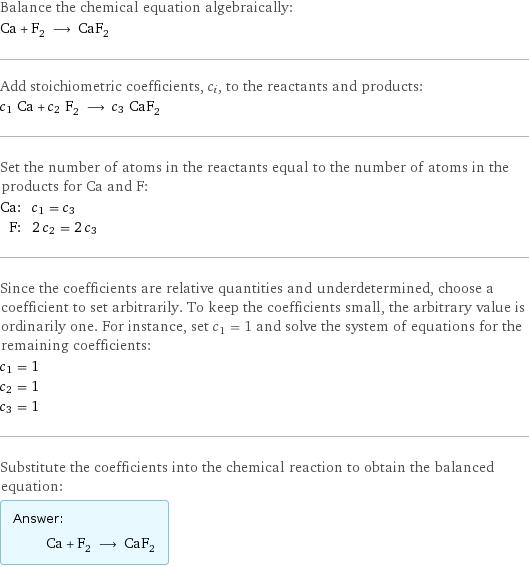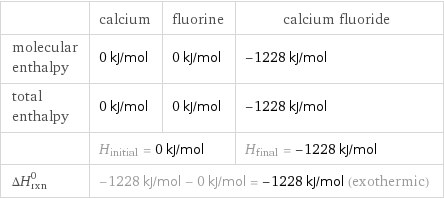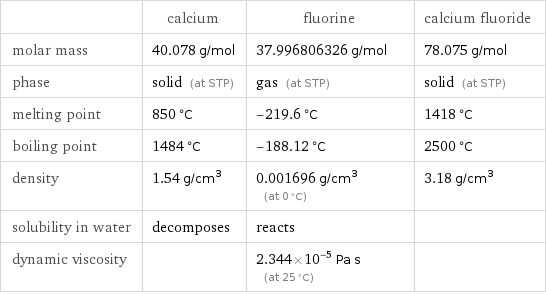Input interpretation

Ca calcium + F_2 fluorine ⟶ CaF_2 calcium fluoride
Balanced equation

Balance the chemical equation algebraically: Ca + F_2 ⟶ CaF_2 Add stoichiometric coefficients, c_i, to the reactants and products: c_1 Ca + c_2 F_2 ⟶ c_3 CaF_2 Set the number of atoms in the reactants equal to the number of atoms in the products for Ca and F: Ca: | c_1 = c_3 F: | 2 c_2 = 2 c_3 Since the coefficients are relative quantities and underdetermined, choose a coefficient to set arbitrarily. To keep the coefficients small, the arbitrary value is ordinarily one. For instance, set c_1 = 1 and solve the system of equations for the remaining coefficients: c_1 = 1 c_2 = 1 c_3 = 1 Substitute the coefficients into the chemical reaction to obtain the balanced equation: Answer: | | Ca + F_2 ⟶ CaF_2
Structures

+ ⟶
Names

calcium + fluorine ⟶ calcium fluoride
Reaction thermodynamics
Enthalpy

| calcium | fluorine | calcium fluoride molecular enthalpy | 0 kJ/mol | 0 kJ/mol | -1228 kJ/mol total enthalpy | 0 kJ/mol | 0 kJ/mol | -1228 kJ/mol | H_initial = 0 kJ/mol | | H_final = -1228 kJ/mol ΔH_rxn^0 | -1228 kJ/mol - 0 kJ/mol = -1228 kJ/mol (exothermic) | |
Equilibrium constant
![Construct the equilibrium constant, K, expression for: Ca + F_2 ⟶ CaF_2 Plan: • Balance the chemical equation. • Determine the stoichiometric numbers. • Assemble the activity expression for each chemical species. • Use the activity expressions to build the equilibrium constant expression. Write the balanced chemical equation: Ca + F_2 ⟶ CaF_2 Assign stoichiometric numbers, ν_i, using the stoichiometric coefficients, c_i, from the balanced chemical equation in the following manner: ν_i = -c_i for reactants and ν_i = c_i for products: chemical species | c_i | ν_i Ca | 1 | -1 F_2 | 1 | -1 CaF_2 | 1 | 1 Assemble the activity expressions accounting for the state of matter and ν_i: chemical species | c_i | ν_i | activity expression Ca | 1 | -1 | ([Ca])^(-1) F_2 | 1 | -1 | ([F2])^(-1) CaF_2 | 1 | 1 | [CaF2] The equilibrium constant symbol in the concentration basis is: K_c Mulitply the activity expressions to arrive at the K_c expression: Answer: | | K_c = ([Ca])^(-1) ([F2])^(-1) [CaF2] = ([CaF2])/([Ca] [F2])](../image_source/f0f3f10335bc6ca77147bab4a40e3469.png)
Construct the equilibrium constant, K, expression for: Ca + F_2 ⟶ CaF_2 Plan: • Balance the chemical equation. • Determine the stoichiometric numbers. • Assemble the activity expression for each chemical species. • Use the activity expressions to build the equilibrium constant expression. Write the balanced chemical equation: Ca + F_2 ⟶ CaF_2 Assign stoichiometric numbers, ν_i, using the stoichiometric coefficients, c_i, from the balanced chemical equation in the following manner: ν_i = -c_i for reactants and ν_i = c_i for products: chemical species | c_i | ν_i Ca | 1 | -1 F_2 | 1 | -1 CaF_2 | 1 | 1 Assemble the activity expressions accounting for the state of matter and ν_i: chemical species | c_i | ν_i | activity expression Ca | 1 | -1 | ([Ca])^(-1) F_2 | 1 | -1 | ([F2])^(-1) CaF_2 | 1 | 1 | [CaF2] The equilibrium constant symbol in the concentration basis is: K_c Mulitply the activity expressions to arrive at the K_c expression: Answer: | | K_c = ([Ca])^(-1) ([F2])^(-1) [CaF2] = ([CaF2])/([Ca] [F2])
Rate of reaction
![Construct the rate of reaction expression for: Ca + F_2 ⟶ CaF_2 Plan: • Balance the chemical equation. • Determine the stoichiometric numbers. • Assemble the rate term for each chemical species. • Write the rate of reaction expression. Write the balanced chemical equation: Ca + F_2 ⟶ CaF_2 Assign stoichiometric numbers, ν_i, using the stoichiometric coefficients, c_i, from the balanced chemical equation in the following manner: ν_i = -c_i for reactants and ν_i = c_i for products: chemical species | c_i | ν_i Ca | 1 | -1 F_2 | 1 | -1 CaF_2 | 1 | 1 The rate term for each chemical species, B_i, is 1/ν_i(Δ[B_i])/(Δt) where [B_i] is the amount concentration and t is time: chemical species | c_i | ν_i | rate term Ca | 1 | -1 | -(Δ[Ca])/(Δt) F_2 | 1 | -1 | -(Δ[F2])/(Δt) CaF_2 | 1 | 1 | (Δ[CaF2])/(Δt) (for infinitesimal rate of change, replace Δ with d) Set the rate terms equal to each other to arrive at the rate expression: Answer: | | rate = -(Δ[Ca])/(Δt) = -(Δ[F2])/(Δt) = (Δ[CaF2])/(Δt) (assuming constant volume and no accumulation of intermediates or side products)](../image_source/f27bf390996ef3b0630c0f4ef8946112.png)
Construct the rate of reaction expression for: Ca + F_2 ⟶ CaF_2 Plan: • Balance the chemical equation. • Determine the stoichiometric numbers. • Assemble the rate term for each chemical species. • Write the rate of reaction expression. Write the balanced chemical equation: Ca + F_2 ⟶ CaF_2 Assign stoichiometric numbers, ν_i, using the stoichiometric coefficients, c_i, from the balanced chemical equation in the following manner: ν_i = -c_i for reactants and ν_i = c_i for products: chemical species | c_i | ν_i Ca | 1 | -1 F_2 | 1 | -1 CaF_2 | 1 | 1 The rate term for each chemical species, B_i, is 1/ν_i(Δ[B_i])/(Δt) where [B_i] is the amount concentration and t is time: chemical species | c_i | ν_i | rate term Ca | 1 | -1 | -(Δ[Ca])/(Δt) F_2 | 1 | -1 | -(Δ[F2])/(Δt) CaF_2 | 1 | 1 | (Δ[CaF2])/(Δt) (for infinitesimal rate of change, replace Δ with d) Set the rate terms equal to each other to arrive at the rate expression: Answer: | | rate = -(Δ[Ca])/(Δt) = -(Δ[F2])/(Δt) = (Δ[CaF2])/(Δt) (assuming constant volume and no accumulation of intermediates or side products)
Chemical names and formulas

| calcium | fluorine | calcium fluoride formula | Ca | F_2 | CaF_2 name | calcium | fluorine | calcium fluoride IUPAC name | calcium | molecular fluorine | calcium difluoride
Substance properties

| calcium | fluorine | calcium fluoride molar mass | 40.078 g/mol | 37.996806326 g/mol | 78.075 g/mol phase | solid (at STP) | gas (at STP) | solid (at STP) melting point | 850 °C | -219.6 °C | 1418 °C boiling point | 1484 °C | -188.12 °C | 2500 °C density | 1.54 g/cm^3 | 0.001696 g/cm^3 (at 0 °C) | 3.18 g/cm^3 solubility in water | decomposes | reacts | dynamic viscosity | | 2.344×10^-5 Pa s (at 25 °C) |
Units
